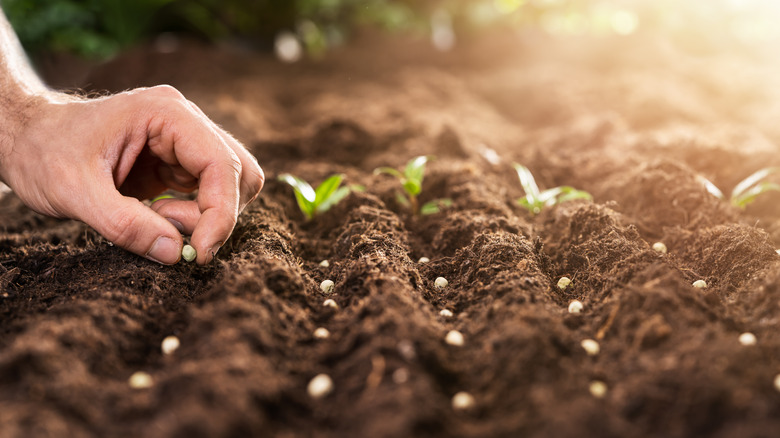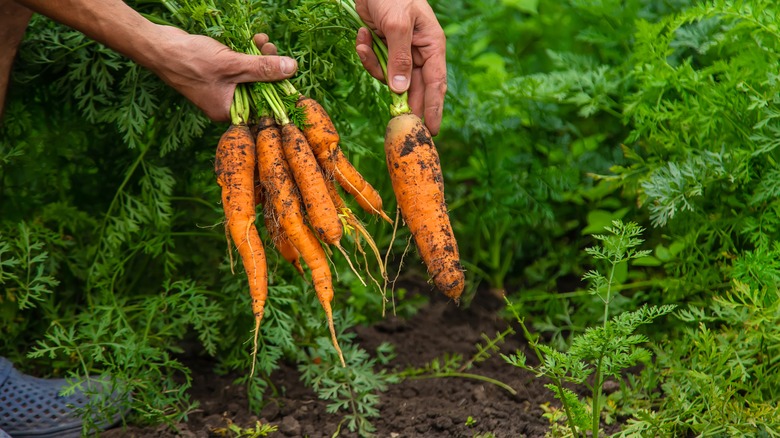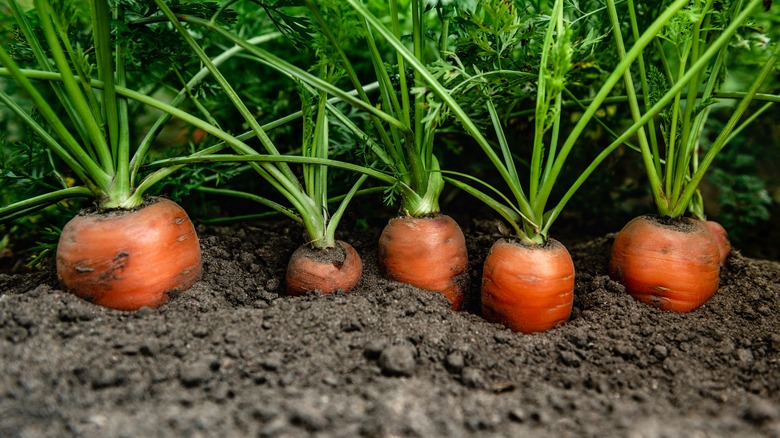The Popular Vegetable Pinterest Recommends Planting In Spring
This is for you if you have yet to be known to have the greenest thumb. Trust us, we get it. Having plants, let alone an entire garden, can be absolutely terrible for those of us not blessed in that area of life. Knowing a proper watering schedule isn't something that's learned overnight. And if you're someone looking for gardening hacks that will give you an instant green thumb this spring, we've got a plant that just might take it easy on you. And according to Pinterest, it's something that'll be pretty in your garden and make for a great side dish with any meal.
Ladies and gentlemen, it's carrots. Similar to tasty veggies like green beans, chives, and beets, there are so many different types of carrots that not attempting to grow them would honestly be a bad move on your part. Pinterest user @brownthumbmama mentions Carnival Blend, Scarlet Nantes, and Tonda di Parigi as just a few options that'll provide some variety on your garden beds this spring. On top of their gorgeous offerings, they're relatively expensive when you buy the seeds in packs, such as Burpee's Kaleidoscope mix carrot seeds at Home Depot for $3.
It's time to grow your carrots
Keep in mind that carrot seeds are tiny, meaning you have to be extra careful about how many you deposit into each planting hole. You want to ensure this doesn't happen because it may stunt the carrot's full potential. Here's a rule of thumb: if you want to grow your carrots to snacking size, space them about 1 inch apart. If you're going for a full-sized option, give each carrot about 2 inches of space when planting. A great variety that's tasty at its full-grown size is a Sugarsnax Hybrid, as it's known for its sweet taste and resistance to disease while growing. If you'd like to grow carrots in containers, that's also a great option for beginners.
Once you've successfully placed the carrot seed of your choice in the ground, cover the top with compost. Beyond keeping the seeds moisturized, this process helps their standing ability. Now, it's time to water. The watering cycle can be difficult for carrots because the seeds are so light and small, so they often get whisked away without you knowing. Some mistakes to avoid when watering your garden are too high pressure or using a heavy stream. Consistent light sprays with your hose or watering can do the trick. Seeds dry out, so it's best to give your freshly planted seeds about 1 inch of water a week. As they age, increase their watering schedules to 2 inches per week.
Deciding if you should thin your carrots
First things first, carrot thinning is the process of removing a few baby plants so the others can grow to full size. Making this call can be difficult because even though you may be able to transplant a few of your carrot thinnings to other spaces, twisted or misshapen roots are a possibility. Remember, this only happens when the growing carrots impede others' growth. Though this usually won't happen if spaced enough apart, sometimes it's inevitable if you're growing so many at once. Roots don't always grow straight, even when using a tool like a seed dispenser.
Keeping growth in mind, it's best to start this cycle when the plants are just 4 inches tall. Removing any carrots that are running into each other or those that aren't growing as quickly is the best option. Just hold the carrot's top between your thumb and forefinger and pull firmly to release it from the soil. Be sure to cover the roots of the other carrots afterward so they're not exposed. You should check your carrot garden around a month later and ensure each plant is about 2 to 3 inches apart. If not, repeat this process. Carrots aren't the biggest fans of being removed, but a proper transplant can be done. Make sure your next spot has about 2 to 4 inches of space, then push it deeply into the soil with your thumb and finger. Gently water afterward.



